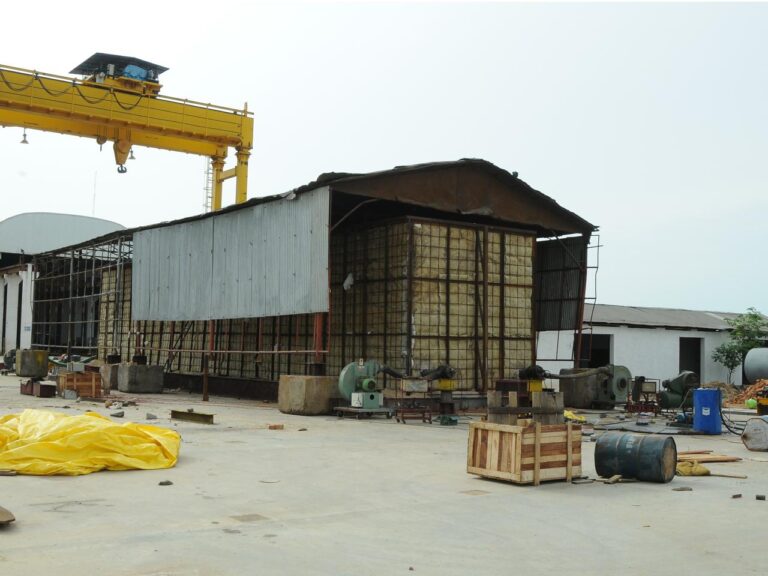
Post-Weld Heat Treatment by Temporary Furnace
Post-weld heat treatment (PWHT) is essential for reducing residual stresses and enhancing the mechanical properties of welded components. When dealing with large structures that cannot be moved or that exceed the capacity of permanent furnaces, a temporary furnace is often constructed on-site. This document describes the process of PWHT using a temporary furnace, with a focus on employing diesel or gas as fuel sources.
What is a Temporary Furnace?
A temporary furnace is a специально constructed enclosure built around the welded component to facilitate PWHT. It is designed to contain heat and maintain the required temperature uniformity for the duration of the heat treatment cycle. These furnaces are typically modular and can be erected and dismantled as needed.
Construction of a Temporary Furnace
The construction of a temporary furnace involves several key steps:
- Site Preparation: A suitable location is selected, and the ground is leveled to provide a stable base for the furnace.
- Framework Erection: A framework, often made of scaffolding or structural steel, is erected around the component to provide support for the furnace walls and roof.
- Insulation: The framework is lined with insulation materials to minimize heat loss. Commonly used materials include:
- Ceramic fiber blankets
- Mineral wool
- Burner Installation: Openings are created in the furnace walls to accommodate burners, which provide the heat source. The number and placement of burners are crucial for achieving uniform temperature distribution.
- Temperature Monitoring: Thermocouples are strategically attached to the component to monitor temperatures throughout the PWHT process. These thermocouples are connected to temperature recorders and controllers to ensure accurate control of the heating cycle.
- Enclosure: The furnace is fully enclosed to create a controlled environment.
Heating the Temporary Furnace
Diesel or gas burners are commonly used to heat temporary furnaces.
- Gas Burners:
- Natural gas or propane (LPG) is used.
- Provide clean and efficient heating.
- Offer good temperature control.
- Diesel Burners:
- Used when gas is not readily available.
- Require careful handling and storage of fuel.
- Produce more emissions compared to gas burners.
- High-velocity burners are preferred to ensure better circulation.
The selection of the fuel depends on:
- Fuel availability and cost
- Required heating capacity
- Emission restrictions
Post-Weld Heat Treatment Process
Typical PWHT Cycle
- Preheat (if required): Slowly bring the part to the starting PWHT temperature.
- Heat-Up: Raise the temperature at a controlled rate (typically ≤100–200 °C/hr depending on material).
- Soak/Hold: Maintain target temperature (e.g., 600–750 °C for carbon steels) for a specified time, usually 1 hour per 25 mm of thickness.
- Cool-Down: Controlled cooling inside the furnace to a set temperature before exposure to ambient air.
All parameters must conform to project specifications and codes like ASME Section VIII, B31.3, or AWS D1.1.
Advantages
- On-Site Treatment: Allows PWHT of large, non-transportable structures.
- Versatility: Can be adapted to various shapes and sizes of components.
- Cost-Effectiveness: Can be more economical than transporting large components to a permanent furnace.
Disadvantages
- Construction and Dismantling: Requires time and effort to erect and dismantle the furnace.
- Temperature Control: Maintaining uniform temperature distribution within a large temporary furnace can be challenging.
- Weather Dependence: The process can be affected by weather conditions, especially for outdoor setups.
- Insulation Requirements: Proper insulation is crucial to minimize heat loss and ensure efficient heating.
- Fuel handling and emissions: Diesel fuel requires careful handling and produces more emissions than gas.
Key Considerations
- Burner Selection and Placement: The type, size, and placement of burners are critical for achieving uniform heating.
- Temperature Control: Accurate temperature measurement and control are essential.
- Insulation: Effective insulation is necessary to minimize heat loss and maintain temperature uniformity.
- Structural Integrity: The furnace structure must be stable and able to withstand the high temperatures.
- Safety: Adequate safety measures must be in place to protect personnel from the high temperatures and potential hazards associated with fuel combustion.
- Environmental Regulations: Compliance with local environmental regulations regarding emissions is essential.
